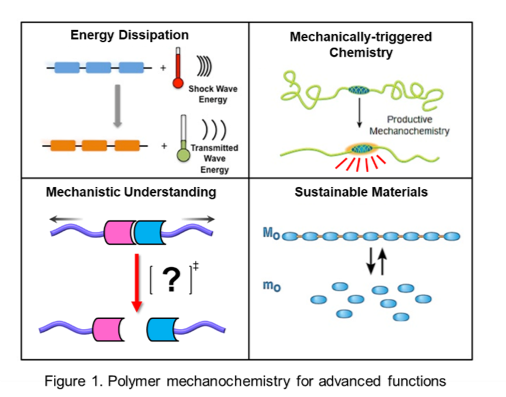Mechanochemistry
At the intersection of mechanics and chemistry, mechanochemistry is a subject that embraces many everyday phenomena including wear and abrasion, friction and lubrication, and stress-accelerated degradation of materials.
Through collaborative research at the University of Illinois Beckman Institute, we are testing the "mechanophore hypothesis" which states that force drives chemical change in selective and productive ways. The goal is to invent materials that have new functionality, such as the ability to repair themselves when damaged. Such materials promise to be safer and last longer than conventional materials. 
Our concept of a mechanophore is a stress or strain activated molecular unit that is inserted into a polymeric material to provide a molecular-scale reading of the local mechanical state or to transform materials properties in response to the local mechanical environment. Molecular designs and research activities are founded on fundamental principles borrowed from polymer science and physical organic chemistry. Building on the mechanophore concept, research encompasses a variety of goals and challenges. Most of our research in mechanochemistry falls into one of four categories: Sustainable materials, Mechanically triggered chemistry, Understanding mechanophore activation and Shock wave energy dissipation (Fig 1.)
• Shock wave energy dissipation (SWED)
Dissipating shock wave energy from detonation is necessary to protect soldiers from traumatic brain injury. Shock waves cause a sudden spike in pressure and temperature when passing through a system. We are developing mechanochemically active materials that respond to these high pressures and undergo chemical transformations that dampen the shock wave energy. This project involves: i) designing and synthesizing molecules that can withstand impinging shock waves; ii) identifying and developing chemical transformations that are activated by shock waves, dissipate energy, and are potentially reversible; and iii) identifying the effect of chemical bonds and atoms involved in chemical transformations on capacity of SWED.
• Mechanically-triggered productive chemistry
Mechanical stress can be used as an external stimulus to trigger downstream, productive chemistry. Mechanical stress has been recognized as one of the most basic and universal signal inputs for cell differentiation and growth. Cellular matrix contains complex chemical network to sense and response to external stress. The group is interested in design and synthesis of new mechanophores that transduce mechanical input into chemical stimuli: e.g., mechanically-triggered depolymerization of metastable polymers to enhance recyclability of materials, generation of protons under force, and recently generation of light. These adaptive mechanophore containing systems have promising potential applications in progenerative medicine.
• Fundamental understanding of mechanophore activation
We are developing a systematic understanding of how mechanophores activate. We strive to probe how mechanical force acts differently from other energy input in activating chemical reactions. Parameters of interest include chemospecificity, regiospecificity, stereospecificity, and force application methods. By varying the backbone chemical designs, tethering positions of polymers, relative stereochemical arrangement of polymer linkers, and ways in which force is applied, we anticipate a sophisticated design roadmap as guideline for novel mechanophores and mechanochemistry.
• Autonomous control of materials life-cycle
Waste reduction is key to a sustainable materials landscape, and it is achievable through life extension and recycling of polymer materials. We seek to extend the lifetimes of widely used polymer materials by incorporating mechanically triggered damage sensing and healing functionalities. When damage occurs, the mechanophores locally activate to report damage or initiate healing. Major areas of focus to achieve these goals are learning structure-property relationships for efficient force transduction in polymers, chemical synthesis of functional mechanophores, and streamlined analytical tools to study these mechanochemical reactions.
Ultimately we believe our group is well positioned to realize the next major advancement in the field of mechanochemistry as well as further our understanding of matter as it experiences mechanical energy input.
